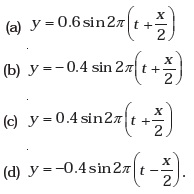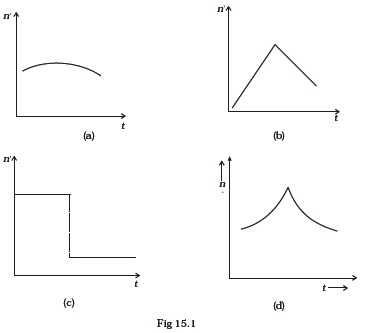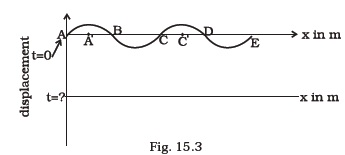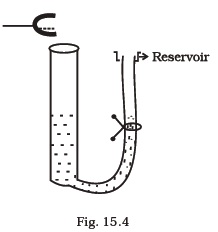Candidates can download NCERT Exemplar Class 11 Physics Chapter 14 from this page. The exemplar has been provided by the National Council of Educational Research & Training (NCERT) and the candidates can check it from below for free of cost. It contains objective, very short answer type, short answer type, and long answer type questions. Along with it, the answer for each question has also been provided. From the NCERT Exemplar Class 11 Physics Chapter 14, candidates can understand the level and type of questions that are asked in the exam.
NCERT Exemplar Class 11 Physics Chapter 14 Waves
NCERT Class 11 Physics Chapter 14 is for Waves. The type of questions that will be asked from NCERT Class 11 Physics Chapter 14 are displayed in the below provided NCERT Exemplar Class 11 Physics Chapter 14. With the help of it, candidates can prepare well for the examination.
Also Check: NCERT Solutions for Class 11 Physics
Multiple Choice Questions (MCQ I)
- Water waves produced by a motor boat sailing in water are
(a) neither longitudinal nor transverse.
(b) both longitudinal and transverse.
(c) only longitudinal.
(d) only transverse. - Sound waves of wavelength λ travelling in a medium with a speed of v m/s enter into another medium where its speed is 2v m/s. Wavelength of sound waves in the second medium is
(a) λ
(b) λ / 2
(c) 2λ
(d) 4λ - Speed of sound wave in air
(a) is independent of temperature.
(b) increases with pressure.
(c) increases with increase in humidity.
(d) decreases with increase in humidity. - Change in temperature of the medium changes
(a) frequency of sound waves.
(b) amplitude of sound waves.
(c) wavelength of sound waves.
(d) loudness of sound waves. - With propagation of longitudinal waves through a medium, the quantity transmitted is
(a) matter.
(b) energy.
(c) energy and matter.
(d) energy, matter and momentum. - Which of the following statements are true for wave motion?
(a) Mechanical transverse waves can propagate through all mediums.
(b) Longitudinal waves can propagate through solids only.
(c) Mechanical transverse waves can propagate through solids only.
(d) Longitudinal waves can propagate through vacuum. - A sound wave is passing through air column in the form of compression and rarefaction. In consecutive compressions and rarefactions,
(a) density remains constant.
(b) Boyle’s law is obeyed.
(c) bulk modulus of air oscillates.
(d) there is no transfer of heat. -


- A string of mass 2.5 kg is under a tension of 200 N. The length of the stretched string is 20.0 m. If the transverse jerk is struck at one end of the string, the disturbance will reach the other end in
(a) one second
(b) 0.5 second
(c) 2 seconds
(d) data given is insufficient - A train whistling at constant frequency is moving towards a station at a constant speed V. The train goes past a stationary observer on the station. The frequency n′ of the sound as heard by the observer is plotted as a function of time t (Fig 15.1) . Identify the expected curve.

Multiple Choice Questions (MCQ II)
- A transverse harmonic wave on a string is described by y (x,t ) = 3.0 sin (36t + 0.018x + π/4) where x and y are in cm and t is in s. The positive direction of x is from left to right.
(a) The wave is travelling from right to left.
(b) The speed of the wave is 20 m/s.
(c) Frequency of the wave is 5.7 Hz.
(d) The least distance between two successive crests in the wave is 2.5 cm. - The displacement of a string is given by
y (x,t) = 0.06 sin (2πx/3) cos (120πt)
where x and y are in m and t in s. The length of the string is 1.5m and its mass is 3.0 10-2 kg
(a) It represents a progressive wave of frequency 60Hz.
(b) It represents a stationary wave of frequency 60Hz.
(c) It is the result of superposition of two waves of wavelength 3 m, frequency 60Hz each travelling with a speed of 180 m/s in opposite direction.
(d) Amplitude of this wave is constant. - Speed of sound waves in a fluid depends upon
(a) directty on density of the medium.
(b) square of Bulk modulus of the medium.
(c) inversly on the square root of density.
(d) directly on the square root of bulk modulus of the medium. - During propagation of a plane progressive mechanical wave
(a) all the particles are vibrating in the same phase.
(b) amplitude of all the particles is equal.
(c) particles of the medium executes S.H.M.
(d) wave velocity depends upon the nature of the medium. - The transverse displacement of a string (clamped at its both ends) is given by y (x,t) = 0.06 sin (2πx/3) cos (120πt). All the points on the string between two consecutive nodes vibrate with
(a) same frequency
(b) same phase
(c) same energy
(d) different amplitude. - A train, standing in a station yard, blows a whistle of frequency 400 Hz in still air. The wind starts blowing in the direction from the yard to the station with a speed of 10m/s. Given that the speed of sound in still air is 340 m/s,
(a) the frequency of sound as heard by an observer standing on the platform is 400 Hz.
(b) the speed of sound for the observer standing on the platform is 350 m/s.
(c) the frequency of sound as heard by the observer standing on the platform will increase.
(d) the frequency of sound as heard by the observer standing on the platform will decrease. - Which of the following statements are true for a stationary wave?
(a) Every particle has a fixed amplitude which is different from the amplitude of its nearest particle.
(b) All the particles cross their mean position at the same time.
(c) All the particles are oscillating with same amplitude.
(d) There is no net transfer of energy across any plane
.(e) There are some particles which are always at rest.
Very Short Answer Type Questions
- A sonometer wire is vibrating in resonance with a tuning fork. Keeping the tension applied same, the length of the wire is doubled. Under what conditions would the tuning fork still be is resonance with the wire?
- An organ pipe of length L open at both ends is found to vibrate in its first harmonic when sounded with a tuning fork of 480 Hz. What should be the length of a pipe closed at one end, so that it also vibrates in its first harmonic with the same tuning fork?
- A tuning fork A, marked 512 Hz, produces 5 beats per second, where sounded with another unmarked tuning fork B. If B is loaded with wax the number of beats is again 5 per second. What is the frequency of the tuning fork B when not loaded?
- The displacement of an elastic wave is given by the function
y = 3 sin ωt + 4 cos ωt.
where y is in cm and t is in second. Calculate the resultant amplitude. - A sitar wire is replaced by another wire of same length and material but of three times the earlier radius. If the tension in the wire remains the same, by what factor will the frequency change?
- At what temperatures (in °C) will the speed of sound in air be 3 times its value at O°C?
- When two waves of almost equal frequencies n1 and n2 reach at a point simultaneously, what is the time interval between successive maxima?
Short Answer Type Questions
- A steel wire has a length of 12 m and a mass of 2.10 kg. What will be the speed of a transverse wave on this wire when a tension of 2.06 * 104N is applied?
- A pipe 20 cm long is closed at one end. Which harmonic mode of the pipe is resonantly excited by a source of 1237.5 Hz ?(sound velocity in air = 330 m s–1)
- A train standing at the outer signal of a railway station blows a whistle of frequency 400 Hz still air. The train begins to move with a speed of 10 m s–1 towards the platform. What is the frequency of the sound for an observer standing on the platform? (sound velocity in air = 330 m s–1)
- The wave pattern on a stretched string is shown in Fig. 15.2. Interpret what kind of wave this is and find its wavelength.

- The pattern of standing waves formed on a stretched string at two instants of time are shown in Fig. 15.3. The velocity of two waves superimposing to form stationary waves is 360 ms–1 and their frequencies are 256 Hz.

(a) Calculate the time at which the second curve is plotted.
(b) Mark nodes and antinodes on the curve.
(c) Calculate the distance between A′ and C ′ . - A tuning fork vibrating with a frequency of 512Hz is kept close to the open end of a tube filled with water (Fig. 15.4). The water level in the tube is gradually lowered. When the water level is 17cm below the open end, maximum intensity of sound is heard. If the room temperature is 20°C, calculate

(a) speed of sound in air at room temperature
(b) speed of sound in air at 0°C
(c) if the water in the tube is replaced with mercury, will there be any difference in your observations? - Show that when a string fixed at its two ends vibrates in 1 loop, 2 loops, 3 loops and 4 loops, the frequencies are in the ratio 1:2:3:4.
Long Answer Type Questions
- The earth has a radius of 6400 km. The inner core of 1000 km radius is solid. Outside it, there is a region from 1000 km to a radius of 3500 km which is in molten state. Then again from 3500 km to 6400 km the earth is solid. Only longitudinal (P) waves can travel inside a liquid. Assume that the P wave has a speed of 8 km s–1 in solid parts and of 5 km s–1 in liquid parts of the earth. An earthquake occurs at some place close to the surface of the earth. Calculate the time after which it will be recorded in a seismometer at a diametrically opposite point on the earth if wave travels along diameter?
- If c is r.m.s. speed of molecules in a gas and v is the speed of sound waves in the gas, show that c/v is constant and independent of temperature for all diatomic gases.
- Given below are some functions of x and t to represent the displacement of an elastic wave.
(a) y = 5 cos (4x ) sin (20t )
(b) y = 4 sin (5x – t/2) + 3 cos (5x – t/2)
(c) y = 10 cos [(252 – 250) πt ] cos [(252+250)πt ]
(d) y = 100 cos (100πt + 0.5x )
State which of these represent
(a) a travelling wave along –x direction
(b) a stationary wave
(c) beats
(d) a travelling wave along +x direction.
Given reasons for your answers - In the given progressive wave
y = 5 sin (100πt – 0.4πx )
where y and x are in m, t is in s. What is the
(a) amplitude
(b) wave length
(c) frequency
(d) wave velocity
(e) particle velocity amplitude. - For the harmonic travelling wave y = 2 cos 2π (10 t – 0.0080 x + 3.5) where x and y are in cm and t is second. What is the phase difference between the oscillatory motion at two points separated by a distance of
(a) 4 m
(b) 0.5 m
(c) λ / 2
(d) 3 λ / 4 (at a given instant of time)
(e) What is the phase difference between the oscillation of a particle located at x = 100 cm, at t = T s and t = 5 s?
Click here to download the NCERT Exemplar Class 11 Physics Chapter 14 Waves
Answers to Multiple Choice Questions



Physics Chemistry Maths Biology
To get study material, exam alerts and news, join our Whatsapp Channel.

